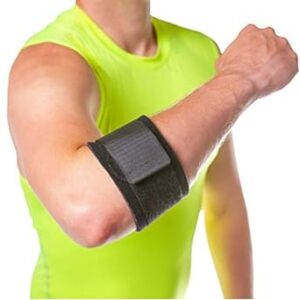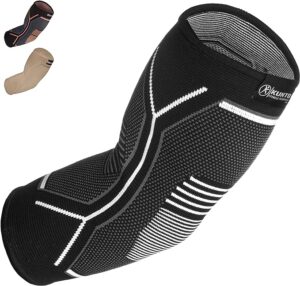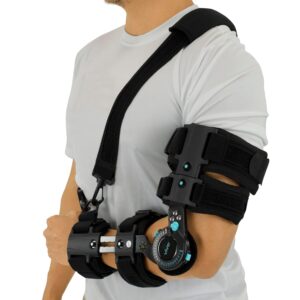If you have ever experienced pain or discomfort in your elbow while playing golf, you’re not alone. Golf elbow, also known as medial epicondylitis, is a common injury among golfers, often caused by repetitive stress on the tendons of the forearm muscles. Fortunately, there’s a solution: the golf elbow brace. In this comprehensive guide, we’ll walk you through everything you need to know about choosing the best golf elbow brace for your swing.
Table of Contents
Introduction to Golf Elbow Brace
What is a Golf Elbow Brace?
A golf elbow brace is a supportive device designed to alleviate pain and discomfort associated with golf elbow. It works by applying pressure to the muscles and tendons around the elbow, helping to reduce strain during your swing.
Importance of Choosing the Right Brace for Your Swing
Selecting the right golf elbow brace is crucial for several reasons. A poorly fitting brace may not provide adequate support or may restrict your range of motion, ultimately impacting your performance on the course. Therefore, understanding your options and considering key factors is essential.
Understanding Golf Elbow
Definition of Golf Elbow
Golf elbow, or medial epicondylitis, is a condition described by pain and inflammation on the inner side of the elbow. It is typically caused by overuse or repetitive motions, such as those involved in swinging a golf club.
Common Causes and Symptoms
The primary cause of golf elbow is repetitive stress on the tendons that attach to the inner side of the elbow. This can result from activities such as golfing, tennis, or other sports that involve gripping and swinging motions. Symptoms may include pain, tenderness, stiffness, and weakness in the affected arm.
Impact on Golf Swing and Performance
Golf elbow can significantly impact your swing mechanics and overall performance on the course. The pain and discomfort may affect your grip strength, accuracy, and power, leading to inconsistencies in your game.
Types of Golf Elbow Braces
When it comes to golf elbow braces, there are several options to choose from, each offering unique features and benefits.
Counterforce Braces
Counterforce braces feature a padded pad that applies pressure to the muscles and tendons on the inner side of the elbow. This helps distribute forces more evenly and reduce strain during the swing.
Compression Sleeves
Compression sleeves are lightweight, elastic garments that provide gentle compression to the elbow area. They improve blood flow, reduce swelling, and offer mild support for golfers with mild to moderate elbow pain.
Strap Braces
Strap braces consist of adjustable straps that wrap around the forearm and apply targeted compression to the affected area. They are versatile and can be customized to provide the desired level of support and comfort.
Hinged Braces
Hinged braces incorporate hinges or joints that allow for controlled movement of the elbow while providing stability and support. They are suitable for golfers with more severe or chronic elbow issues who require greater immobilization.
Factors to Consider When Choosing a Golf Elbow Brace
Selecting the right golf elbow brace requires careful consideration of several factors to ensure optimal fit, comfort, and effectiveness.
Severity of the Condition
The severity of your golf elbow symptoms will influence the type of brace you need. Mild cases may only require a compression sleeve, while more severe or chronic conditions may necessitate a hinged brace for maximum support.
Comfort and Fit
Comfort is paramount when wearing a golf elbow brace, especially during long rounds of golf. Look for braces made from breathable, moisture-wicking materials that conform to the shape of your arm without causing irritation.
Range of Motion
Consider how much movement you need in your elbow during your swing. While some braces offer full range of motion, others may restrict movement to provide greater stability and protection.
Durability and Material
Choose a brace that is durable enough to withstand the rigors of frequent use on the golf course. High-quality materials such as neoprene, nylon, and spandex offer durability, flexibility, and moisture resistance.
Support and Stability
The primary purpose of a golf elbow brace is to provide support and stability to the elbow joint. Look for features such as reinforced straps, padded cushions, and adjustable closures to ensure a secure fit and maximum support.
Adjustability and Ease of Use
An adjustable brace allows you to customize the fit and compression level to suit your preferences. Additionally, easy-to-use closures and fasteners make it simple to put on and take off the brace as needed.
Reviews of Top Golf Elbow Braces
To help you narrow down your options, here are reviews of three top-rated golf elbow braces on the market:
Product 1: BraceAbility Counterforce Brace
Features:
- Padded pad for targeted pressure.
- Adjustable strap for a customizable fit.
- Breathable and lightweight material.
Pros:
- Provides excellent support and stability.
- Relieves pain and discomfort during swings.
Cons:
- May feel bulky for some users.
- Sizing runs slightly small.

Product 2: Kunto Fitness Elbow Brace Compression
Features:
- Elastic fabric for gentle compression.
- Moisture-wicking and odor-resistant.
- Seamless design for enhanced comfort.
Pros:
- Offers mild support for mild to moderate pain.
- Allows for full range of motion.
Cons:
- Compression may be too light for some users.
- Durability issues reported after prolonged use.

Product 3: Hinged Brace
Features:
- Hinged design for controlled movement.
- Adjustable straps for a secure fit.
- Durable construction with padded support.
Pros:
- Provides maximum stability and protection.
- Ideal for severe or chronic elbow issues.
Cons:
- Limited range of motion compared to other braces.
- Higher price point may deter some buyers.

Tips for Proper Fit and Usage
Once you’ve chosen the right golf elbow brace, it’s essential to ensure proper fit and usage for optimal effectiveness.
Measuring for the Right Size
Refer to the manufacturer’s sizing guide to determine the correct size for your arm. Measure the circumference of your forearm and compare it to the provided measurements to find the best fit.
Proper Placement and Adjustment
Position the brace so that the padded pad or compression sleeve covers the inner side of your elbow. Adjust the straps or closures until the brace feels snug but not too tight. Avoid over-tightening, as this can restrict blood flow and cause discomfort.
Frequency and Duration of Use
Wear the brace during activities that aggravate your golf elbow symptoms, such as swinging a golf club. Start with short periods of use and gradually increase the duration as your symptoms improve. Remove the brace if you experience any numbness, tingling, or skin irritation.
Maintenance and Care
To prolong the life of your golf elbow brace, follow the manufacturer’s care instructions carefully. Hand wash or machine wash the brace in cold water with mild detergent, and air dry it away from direct heat and sunlight. Try not to utilize blanch or cleansers, as they can harm the flexible filaments.
Exercises and Stretches to Supplement Brace Usage
In addition to wearing a golf elbow brace, incorporating specific exercises and stretches into your routine can help improve strength, flexibility, and overall joint health.
Strengthening Exercises
- Wrist twists: Grasp a lightweight free weight with your palm looking up. Curl your wrist upward, then slowly lower it back down.
- Reverse wrist curls: Perform the same motion as wrist curls, but with your palm facing down.
- Grip squeezes: Squeeze a soft ball or stress ball in your hand, then release.
Flexibility Stretches
- Wrist flexor stretch: Expand your arm before you with your palm looking up. Use your opposite hand to gently pull back on your fingers until you feel a stretch in your forearm.
- Wrist extensor stretch: Extend your arm in front of you with your palm facing down. Use your opposite hand to gently press down on your fingers until you feel a stretch in your forearm.
Warm-up Routines
Before heading out onto the golf course, incorporate dynamic warm-up exercises to prepare your muscles and joints for activity. This may include arm circles, wrist rotations, and shoulder shrugs to increase blood flow and flexibility.
Conclusion
In conclusion, selecting the best golf elbow brace for your swing can make a significant difference in your comfort, performance, and overall enjoyment of the game. By understanding your options, considering key factors, and following expert recommendations, you can find a brace that meets your needs and helps you play your best golf.
FAQs (Frequently Asked Questions)
How do I know if I have golf elbow?
Golf elbow is typically characterized by pain and tenderness on the inner side of the elbow, which may worsen with gripping or lifting objects. In the event that you experience these side effects, it’s fundamental to talk with a medical services proficient for an exact finding.
Can I still play golf with a golf elbow brace?
Yes, many golfers continue to play golf while wearing a golf elbow brace. In fact, wearing a brace can help alleviate pain and discomfort, allowing you to enjoy the game without aggravating your symptoms.
How long would it be a good idea for me to wear a golf elbow support every day?
The duration of brace wear depends on the severity of your symptoms and your level of comfort. Start by wearing the brace during activities that exacerbate your symptoms, such as golfing, and gradually increase the duration as needed.
Are there any exercises I can do to prevent golf elbow?
Incorporating strengthening exercises and stretches into your routine can help improve elbow strength and flexibility, reducing the risk of injury. However, it’s essential to consult with a healthcare professional or physical therapist for personalized recommendations.
Can I wash my golf elbow brace?
Yes, most golf elbow braces can be hand washed or machine washed in cold water with mild detergent. Be sure to follow the manufacturer’s care instructions to maintain the integrity and effectiveness of the brace.